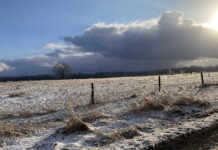A few days ago I took my wife to the Pittsburgh airport, a distance of about 78 miles.
The first 43 miles wind through rural country, and along the way we passed three road-killed skunks. We counted another four just by the odor they left behind. It’s that time of year. Skunks are on the move.
From mid-February through early March, females are in heat. Don’t be surprised to see skunks roaming the countryside the next few weeks. Males wander from den to den searching for reproductive fulfillment.
After mating, males resume the search and may mate with many females as long as they remain receptive. Likewise, females may accept the advances of more than one male.
This mating system, one male mating with several females, is called polygyny.
In early May, about 63 days after mating, females give birth. A yearling female typically has four kits. Older moms have six to eight kits per litter. The nest may be in a tunnel dug by the female herself or it may be an old groundhog burrow.
Kits weigh about one ounce at birth, are sparsely furred, and already have their characteristic black and white markings. At two weeks they are fully furred.
A week later their eyes open, and they can discharge small amounts of musk. At six to eight weeks of age, weaning occurs and the kits join mom on her nightly hunting forays.
Watch for these entertaining family groups in late June. Just remember to keep your distance.
A night hike in the woods in June sometimes results in a memorable encounter. Usually a skunk’s first response to danger is to flee. But if you suddenly meet a bold skunk on a trail, stop and slowly retreat.
Typically an agitated skunk arches its back, raises its tail, and stamps its front feet. Sometimes it emits an ear-shattering high-pitched squeal. That means you’ve got just a few seconds to get out of range.
In an instant, a skunk can whip its head and rear end around into a U-shape with head and tail facing the threat. It can accurately spray a mist of musk up to ten feet, and the odor can carry more than a mile downwind.
A direct hit means clothes in the trash and a few baths in tomato juice or vinegar to neutralize the odor. And even that won’t keep the encounter a secret. Traces of musk can linger for days.
A skunk-bombed dog will usually be banished to an outdoor pen for at least several days.
Skunk musk originates in two anal scent glands. Each gland contains about one tablespoon of musk, enough for about six blasts. So don’t assume that the tank is empty after the first shot.
A direct shot of skunk musk to the face can cause nausea and even temporary blindness, but these symptoms fade quickly.
Another reason to avoid contact with skunks is that they, like all mammals, can carry rabies. Even cute little baby skunks can spray and carry rabies, so warn the kids.
Getting too close to a skunk, for any reason, is foolish. But skunks aren’t all bad. In my backyard, they often dig up yellow jacket nests. Skunks also eat mice.
Because they are rather slow and awkward, skunks use the same “stalk and ambush” style that cats find so effective.
And farmers and gardeners should appreciate a skunk’s voracious appetite for pests such as armyworms, cutworms, potato beetles, June beetles, grasshoppers and squash bugs.
Skunks also eat bees and honey. Apparently, stinging insects have no effect on skunks. Because skunks are poor climbers, beekeepers can minimize such raids by simply placing hives on stands that are four feet tall.
In fact, there isn’t much skunks don’t eat. That’s why they’re called “opportunistic omnivores.” They eat just about anything, anywhere, anytime — insects of all sorts, chipmunks, bird eggs, baby rabbits, earthworms, snakes, crayfish, frogs, fruits, grass, corn, nuts, roots, carrion and, of course, garbage.














Thanks, Scott! Good write up here.
They tell us: “Beware the Ides of March,” well…I’d say “Beware the Raised Striped Tail!”